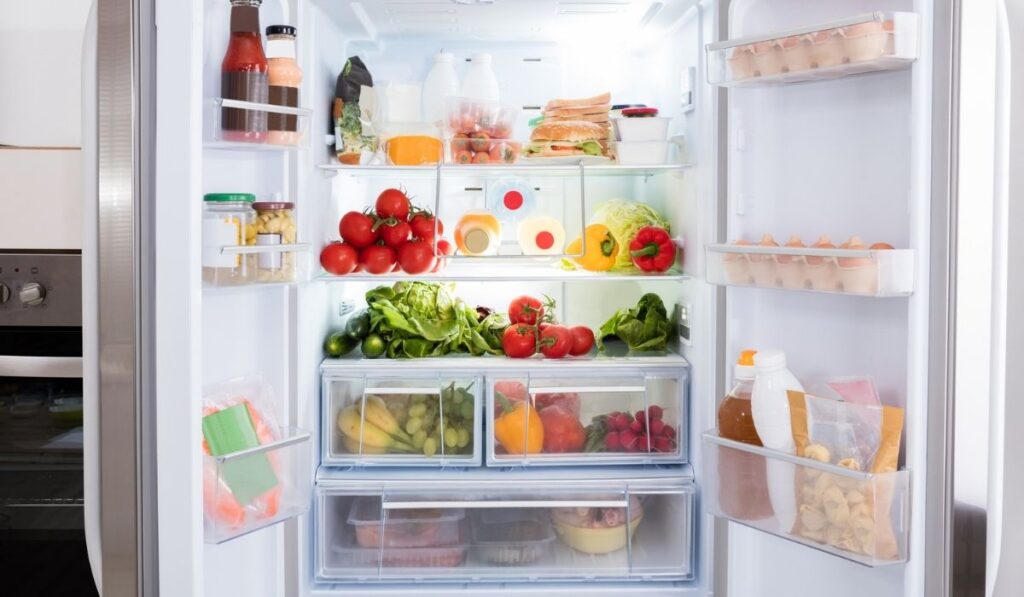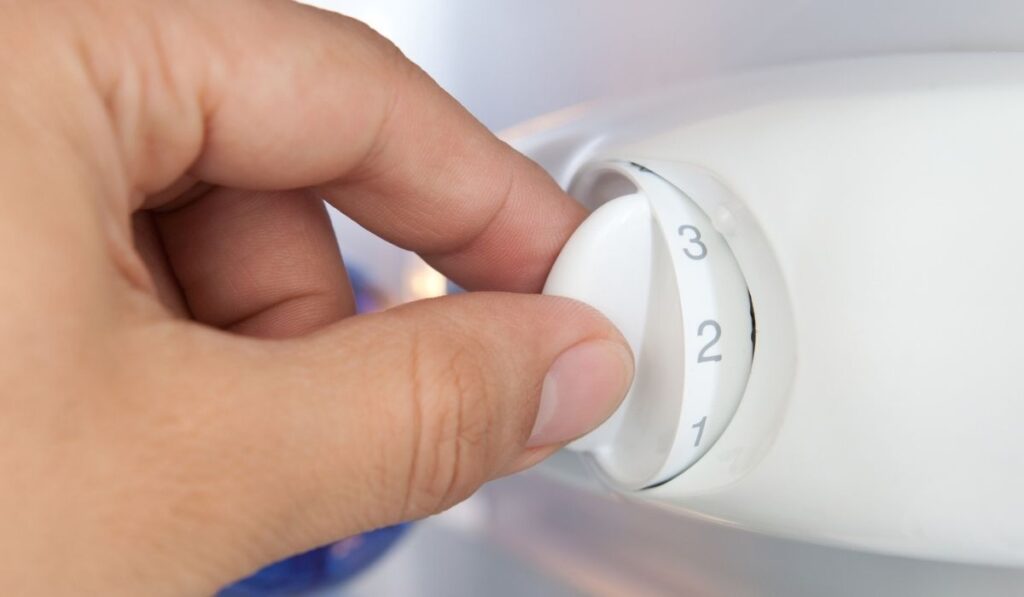Have you ever opened your fridge to find all of your fresh food wholly frozen over, as if it were in the freezer? You’re not alone. This isn’t a particularly common problem, but it’s not unheard of. Don’t worry, though; we’re going to help you solve this frustrating issue.
If your fridge is too cold, check that the temperature is set correctly. If it is, proceed to check (and adjust) the door seals, the thermostat, the damper, and the condenser coils. If those things are all functioning, you may need a professional to check the fridge’s main control board.
In this article, we’ll cover the potential reasons why your fridge might be freezing things, and we’ll go through a number of potential fixes so that you can prevent future freezes. After all, food shouldn’t be served frozen — unless it’s ice cream, of course.
Why Your Refrigerator Is Freezing Everything

There are several reasons your fridge might be freezing your fresh food. Let’s examine some of them.
Wrong Temperature
The ideal temperature range for storing fresh food in the refrigerator is between 38 and 40 degrees Fahrenheit (equivalent to 3.33 to 4.44 degrees Celsius).
If you notice that your food is freezing, it might be because you set the temperature of your refrigerator to a level below this range.
To correct the issue, adjust the temperature to the acceptable level and wait for twenty-four hours to let the changes take effect.
Blocked Air Vents
Your refrigerator’s air vents allow cold air to flow through the fridge, keeping the same temperature throughout. The air vents also have the additional function of indicating if the refrigerator’s thermostat is high or low.
When you place food items directly in front of the air vents, it blocks the free flow of cold air within the refrigerator.
Bad or Deteriorating Door Seals
The job of a refrigerator’s door seals is to keep the cold air within the fridge. If the door seals are faulty, the fridge doors won’t close properly. As a result, the refrigerator will need to work extra hard to stay cold.
The extra cooling from the fridge could lead to your food freezing. Check your door seals to see if they’re the culprit. If they are, replace them.
Thermostat Issues
A bad thermostat is another possible reason that your refrigerator is freezing all the food. If you tried adjusting the refrigerator’s temperature, this may be the case, but it’s still freezing over.
A faulty thermostat might make the fridge too cold, which leads to food freezing. If you want to confirm whether the thermostat is the problem, check it with a multimeter like the Etekcity Digital Multimeter (on Amazon). Check the refrigerator’s manual to confirm the location of the thermostat.
Damper Stuck in Open Position
The damper is part of a fridge/freezer combo that regulates cool air flow from the freezer into the fridge. If the damper fails to close when it’s meant to, excess cold air fills the fridge.
So if your refrigerator’s damper gets stuck in an open position, there’s a high possibility that the food in your fridge will get too cold.
Dirty or Dusty Condenser Coils
You might be surprised by the fact that dirty condenser coils could cause food in the refrigerator to freeze over. The function of the condenser coils is to get rid of heat from the fridge. When dust and other debris make the coils dirty, getting rid of heat becomes more difficult for the fridge.
When the refrigerator has to work even harder due to dirty condenser coils, it consumes more energy, and the fridge gets colder.
Faulty Main Control Board
Before checking the main control board of the refrigerator, be sure that all other probable causes for freezing have been tested. Only when you’ve ruled out the other possible issues should you check the main control board to see if it needs to be repaired or replaced.
The main control board basically controls everything about the refrigerator. Only an expert should check it.
How Do I Fix a Refrigerator That Freezes Food?
Now that we have examined why your refrigerator might be freezing your food let’s go through some steps for fixing it.
Change the Refrigerator’s Temperature

The temperature gauge is a knob with numbers indicating the temperature in older refrigerators. If that’s the case with your fridge, set the temperature dial to the recommended temperature.
There is a digital display with modern refrigerators that shows the actual temperature. Use the up and down keys to set the right temperature.
After setting the temperature, leave the refrigerator for twenty-four hours before checking the temperature again. If there hasn’t been any change, get a refrigerator thermometer like this one (on Amazon) and put it in the fridge.
Use the thermometer to check the ambient temperature and see how it compares to the reading from your fridge’s original thermometer.
Change Damaged Door Seals
The only solution for lousy door seals is to replace them. Apart from freezing your food, terrible door seals make your refrigerator consume more energy, which will increase your electricity bill.
As soon as you notice bad door seals, replace them. You can move food away from the damaged area as a temporary fix in the meantime.
Clean Your Condenser Coils
Like bad door seals, dirty condenser coils make your refrigerator work harder, thereby increasing your electricity bills. Cleaning your condenser coils isn’t a difficult task.
If the coils have a cover or grate protecting them, remove it carefully, then use a soft brush to clean the dust and dirt.
Even if your condenser coils aren’t the source of the problem, it’s a good thing to ensure they are free of dust and all forms of dirt. Be careful not to damage the coils and cause further damage.
Check and Unblock Air Vents
If the problem is with the air vents, rearrange the items in the refrigerator to unclog the air vent. There should be at least five inches of space around the air vent so that it can circulate the cool air properly.
Check and Fix Your Thermostat
The location of a refrigerator’s thermostat differs from one brand to another. The easiest way to find it is to look through the owner’s manual. The thermostat is usually mounted on the evaporator tube and covered by a protective panel.
Check the thermostat settings to confirm it’s not set too low. If it is, restore it to the recommended settings, and wait for twenty-four hours. If there’s no change, then you have to change the thermostat.
Repair the Damper and Other Mechanical Issues
There are several reasons why your damper might not close. The first thing to do is to confirm that mechanical problems don’t cause the issue. The next suspect is the temperature sensor.
Modern refrigerators use auto dampers. These auto dampers employ an electronic temperature sensor that determines when the damper should open and close depending on the refrigerator’s temperature.
The sensor has a connector that links it to the board. If the sensor is the issue, removing and replacing it is small.
The easiest way to check if the sensor is the problem is to check the sensor’s resistance with a multimeter. The manufacturer provides the resistance readings of various sensors at specific temperatures. If the reading differs from what the manufacturer says, the sensor is faulty and needs replacing.
Conclusion
Frozen food in your fridge is not ideal. Your refrigerator is supposed to keep food fresh, after all. Now that you understand why this problem might arise solving it shouldn’t be a big deal.
If you still aren’t sure what the problem is, check with the manufacturer or another professional. They should be able to provide a technician or inform you of other possible solutions.
